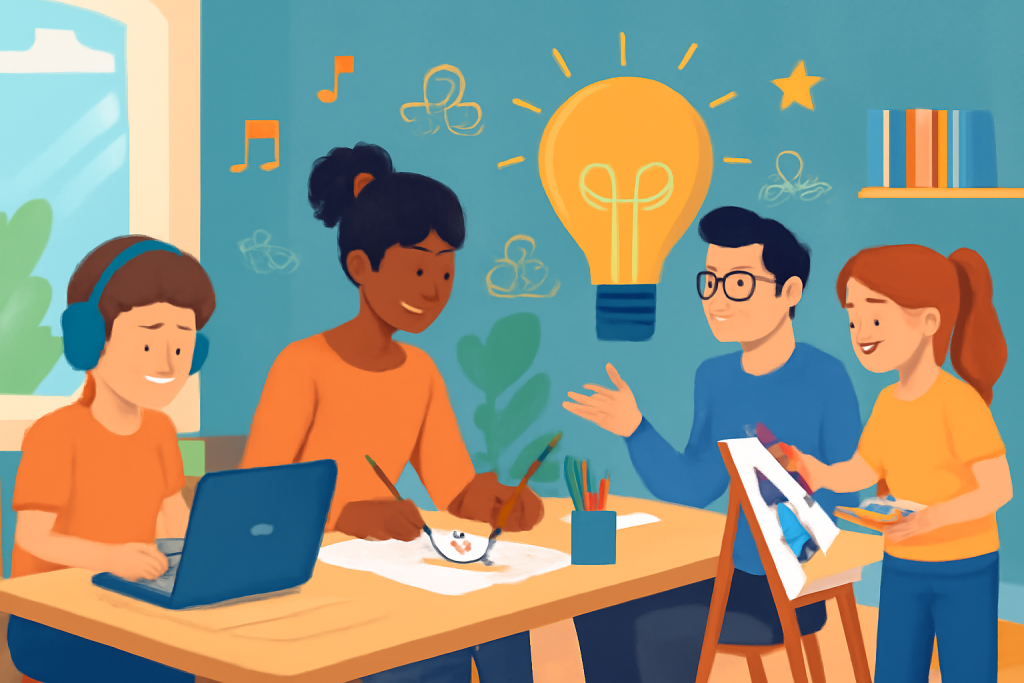Creativity is more essential than ever in today’s fast-changing world. Whether you’re raising a child or looking to enhance your own creative skills, finding effective ways to foster creativity in children and adults can unlock untapped potential and improve problem-solving abilities. This article explores innovative and evidence-based strategies to boost creativity across all ages, emphasizing current trends like digital tools, mindfulness, and cross-disciplinary learning.

How to Foster Creativity in Children and Adults Using Technology
One of the most effective ways to foster creativity in children and adults today is through the use of technology. Digital platforms like coding apps, digital art software, and virtual reality offer engaging, hands-on experiences that open new pathways for creative expression.
For children, programs like Scratch and Tynker introduce coding creatively through storytelling and game design, making learning interactive and fun. Adults can use tools like Adobe Creative Cloud or online brainstorming platforms to visualize ideas and experiment freely. Research indicates that technology combined with creative activities enhances cognitive flexibility and engagement (Katz & Marshall, 2020).
Moreover, digital creative communities foster collaboration and feedback, expanding opportunities to share and refine ideas globally.
Mindfulness Practices That Help Foster Creativity in Children and Adults
Mindfulness is another powerful way to foster creativity in children and adults by cultivating focused attention and openness to new ideas. Practicing meditation, journaling, or mindful movement helps reduce mental clutter and improves divergent thinking—the ability to generate multiple solutions to a problem.
In schools, mindfulness-based art therapy programs have boosted children’s focus and creative output. Adults practicing mindfulness have shown improved creative problem-solving skills and increased innovation capacity (Colzato, Ozturk & Hommel, 2012).
Integrating short mindfulness sessions into daily routines creates a calm, receptive mindset that encourages creative breakthroughs.
Cross-Disciplinary Learning to Boost Creativity in Children and Adults
Encouraging exploration across various disciplines is a key approach to foster creativity in children and adults. When individuals engage with diverse fields—such as combining art with science or music with technology—they develop the ability to make novel connections and think more flexibly.
The STEAM (Science, Technology, Engineering, Art, and Math) education movement exemplifies this by integrating arts into traditional STEM subjects to promote holistic creative thinking. Adults benefit similarly by pursuing hobbies outside their professional expertise, such as creative writing or learning an instrument.
Research shows that interdisciplinary learning enhances cognitive flexibility and problem-solving, which are crucial for creative success (Root-Bernstein & Root-Bernstein, 2013).
Creating Supportive Environments to Foster Creativity in Children and Adults
A supportive environment that encourages experimentation and tolerates failure is essential to truly foster creativity in children and adults. When individuals feel psychologically safe, they are more likely to take risks and explore unconventional ideas.
In educational settings, emphasizing effort over perfection fosters resilience and creative risk-taking among children. For adults, workplaces that support innovative projects and do not penalize failure promote greater creative output (Edmondson, 2019).
Creating such environments involves open communication, encouragement of curiosity, and valuing diverse perspectives.
Practical Daily Tips to Foster Creativity in Children and Adults
To consistently foster creativity in children and adults, incorporate these simple practices into everyday life:
- Schedule dedicated creative time free from distractions.
- Maintain a creativity journal for capturing ideas and reflections.
- Combine routine with new experiences like museum visits or nature walks.
- Encourage “what if” questions to stimulate imaginative thinking.
- Use games and puzzles to develop flexible problem-solving skills.
These small habits help sustain a creative mindset and nurture ongoing innovation.
Conclusion
Successfully fostering creativity in children and adults involves intentional practices combining technology, mindfulness, interdisciplinary learning, and supportive environments. When these strategies are applied consistently, they enhance imaginative thinking, problem-solving, and adaptability—skills vital for personal and professional growth.
By embracing these evidence-based ways to foster creativity in children and adults, anyone can unlock their creative potential and thrive in an ever-evolving world.
References
- Katz, S. & Marshall, J. (2020) ‘Technology and creativity: Impact of digital tools on creative cognition.’ Journal of Educational Psychology, 112(4), pp. 650-660.
- Colzato, L.S., Ozturk, A. & Hommel, B. (2012) ‘Meditate to create: The impact of focused-attention and open-monitoring training on convergent and divergent thinking.’ Frontiers in Psychology, 3:116. https://doi.org/10.3389/fpsyg.2012.00116
- Root-Bernstein, R. & Root-Bernstein, M. (2013) ‘The Art and Craft of Science: Interdisciplinary Learning for Creative Cognition.’ Creativity Research Journal, 25(2), pp. 179-189.
- Edmondson, A.C. (2019) The Fearless Organization: Creating Psychological Safety in the Workplace for Learning, Innovation, and Growth. Wiley.





